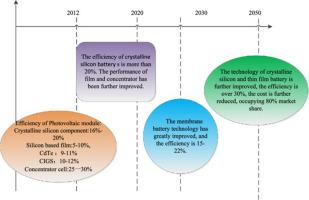Investigating the properties of semiconductors solar cells technologies, efficiency for photovoltaic cells and application graphene for solar cells : A review
引用次数: 0
Abstract
The increase in global energy consumption and greenhouse gas emissions over the last century has been related to increased pollution and irreversible damage to important resources. To reduce the global dependence on natural resources and pollution, many scientific efforts have been made to reduce the energy production costs from renewable sources, including efforts to exploit the inherent properties of semiconductors to generate electricity using sunlight. Solar batteries based on the first semiconductor, with efficiencies of >10 %, were produced between 1950 and 1960. Currently, 80–90 % of photovoltaic components worldwide are made from silicon sheets. The use of semiconductors is revolutionizing the optical and electronics industries. Understanding the properties of semiconductors is important for understanding the activity of solar cells and improving their performance and conversion efficiencies. To generate electricity, solar cells must produce electricity and tension. Electricity is produced by motion loads, and tension requires a difference between electronic energy levels. Metal and insulation are free loads, and there is a prohibition between electronic energy levels. However, semiconductors have several advantages over metals. For a highly effective conversion, an effective load must occur, which depends on factors such as the diffusion length of the electrons and holes. The creation and recombination of electrons and their vulnerabilities are of utmost importance in solar cells. This article offers a detailed review of advanced solar sun cell technologies, new materials, loss mechanisms, and efficiency-improvement techniques. Research includes silicon materials (Si) and III-V, punishment lines of lead, durable embryos, organic photovoltaics, and solar cells that are aware of colors. In this context, promising architectural progress with graphene and super materials has been emphasized in the literature. This study also included different types of losses, including interior and external losses, in the single solar cells. Techniques to improve efficiency, such as light management and spectrum use, have been evaluated. Although the effect of solar cells based on Si is delayed by approximately 25 %, the effectiveness of multi-transition solar cells based on III-V semiconductor compounds is improved. However, mixed III–V semiconductors are subject to high material costs. In addition, indium gallium and cadmium telluride solar battery technologies can compete with crystalline solar cells owing to recent progress in cell performance. However, environmental concerns and open tensions regarding the remaining Cd are prevalent. In contrast, perovskite solar cells are highly efficient for both single and multiple arrays. The industrialization of perovskite solar cells requires consideration of device degradation, hysteresis, and film quality.

半导体太阳能电池技术、光伏电池效率及石墨烯在太阳能电池中的应用综述
上个世纪全球能源消耗和温室气体排放的增加与污染的增加和对重要资源的不可逆转的破坏有关。为了减少全球对自然资源和污染的依赖,已经做出了许多科学努力来降低可再生能源的能源生产成本,包括努力利用半导体的固有特性来利用阳光发电。1950年至1960年间,第一批以半导体为基础的太阳能电池生产出来,效率为10%。目前,全球80 - 90%的光伏组件是由硅片制成的。半导体的使用正在给光学和电子工业带来革命性的变化。了解半导体的性质对于了解太阳能电池的活性和提高其性能和转换效率非常重要。为了发电,太阳能电池必须产生电能和张力。电是由运动载荷产生的,而张力需要电子能级之间的差异。金属和绝缘是自由负载,电子能级之间有一个禁止。然而,半导体比金属有几个优点。为了实现高效的转换,必须产生有效负载,这取决于电子和空穴的扩散长度等因素。电子的产生和重组及其脆弱性在太阳能电池中至关重要。本文详细介绍了先进的太阳能电池技术、新材料、损耗机制和效率改进技术。研究包括硅材料(Si)和III-V,铅的惩罚线,耐用胚胎,有机光伏和能感知颜色的太阳能电池。在这种背景下,石墨烯和超级材料在建筑方面的进展已经在文献中得到了强调。本研究还包括了不同类型的损耗,包括单个太阳能电池的内部损耗和外部损耗。提高效率的技术,如光管理和光谱利用,已经进行了评估。尽管基于Si的太阳能电池的效果延迟了约25%,但基于III-V半导体化合物的多过渡太阳能电池的效率得到了提高。然而,混合III-V半导体受制于高材料成本。此外,由于最近电池性能的进步,铟镓和碲化镉太阳能电池技术可以与晶体太阳能电池竞争。然而,关于剩余镉的环境问题和公开紧张局势普遍存在。相比之下,钙钛矿太阳能电池在单阵列和多阵列中都是高效的。钙钛矿太阳能电池的产业化需要考虑器件退化、迟滞和薄膜质量等问题。
本文章由计算机程序翻译,如有差异,请以英文原文为准。
求助全文
约1分钟内获得全文
求助全文

 求助内容:
求助内容: 应助结果提醒方式:
应助结果提醒方式:


